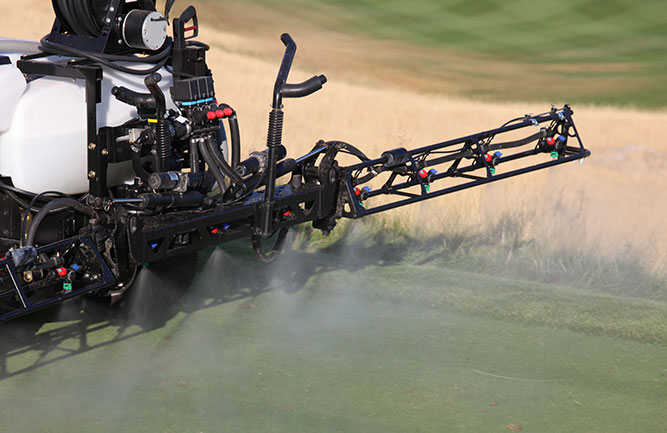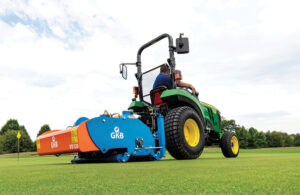Supers share the new technology you need to know about
Old habits die hard in the golf course maintenance industry. But with the golf boom over the last few years, some of those old habits will have to be on the chopping block soon in order to keep up.
Luckily, there are hundreds of new technologies in the market that can help make the job of a golf course superintendent easier. On the other hand, it’s a crowded technology space, especially in this industry.
To help you sift through the tall grass, we asked several friends of the magazine to reveal what they believe are the next game-changing technologies in golf course maintenance.
We took their advice and sought to learn more. Here’s what we found.
Photo: Gerald Flaherty
Track and store data
Gerald Flaherty, superintendent of The Valley Club in Sun Valley, Idaho, recalls a time when he could have used his taskTracker software. Flaherty faced budget cuts in 2008 and had to defend his budget.
“They went and cut it right down the line. I didn’t have any defense on that,” he says.
At its base, taskTracker allows users to create, share and store job boards. Flaherty and Jaime Sharp, director of golf at The Valley Club, designed the system in 2013 to make Flaherty’s job easier by helping him collect data on his crew’s activity.
That hasn’t changed since taskTracker’s launch. The program still allows users to create and edit boards from any internet-connected device.
Facing a similar situation as 2008 at the start of the COVID- 19 pandemic, Flaherty presented real numbers on how much cutting certain services would cost. He says he shared how much not raking bunkers on the weekends and mowing the greens one less day a week would save.
The result? The course didn’t cut his budget.
“I put it on them this time,” Flaherty says.
Recently, taskTracker started moving toward equipment tracking. A new feature added in 2022 allows superintendents to track how much gas they use. Crew members scan QR codes on equipment and input how much gas they put in the tank.
Flaherty says the recent rise in gas prices inspired that change, although superintendents have requested it for a while.
“Now we have a whole section on there for our equipment,” says Flaherty. “So, if you want to change the oil on something every 300 hours, it knows that piece of equipment has been out for 300 hours, and it’s going to send the mechanic a work order reminder saying you need to bring that piece of equipment in.”
The system also allows for tracking of course measurements, like green speeds, clipping yields and moisture content.
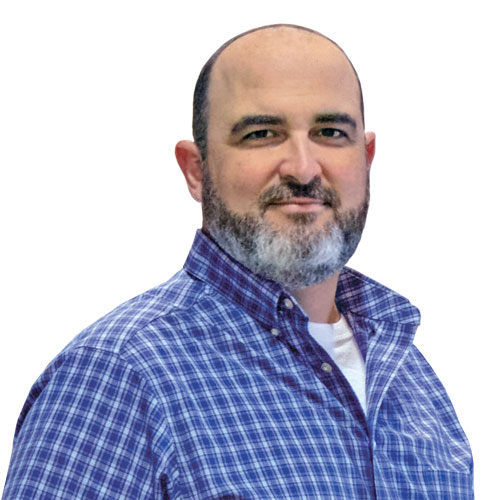
Photo: Ian Rodriguez
Taking the fight to ABWs
Ian Rodriguez, Ph.D., technical services manager for Quali-Pro, has appeared plenty of times in this magazine, spreading the gospel of Quali-Pro’s Suprado insecticide. Suprado, an insect growth regulator (IGR), targets the annual bluegrass weevil (ABW) at several stages of its life cycle. But most notably, it inhibits an adult ABW’s ability to lay eggs instead of killing them directly.
The active ingredient in Suprado, novaluron, is a new name to not only the golf course industry but to ABWs too.
“(Novaluron) has never been labeled for turf. That’s significant because there’s a growing resistance to additional chemistries in some ABW populations,” says Rodriguez.
Suprado is still undergoing testing as Quali-Pro looks to answer questions such as, ‘Can you wait until the following day to water it in?’ Rodriguez also says it’s being tested on a number of other turf pests as well.
During testing on ABWs, Suprado provided what Rodriguez called excellent levels of control against medium-sized ABW larva. According to Rodriguez and Ben McGraw, Ph.D., who conducted three seasons of Quali-Pro’s testing on ABW, they achieved 95 to 100 percent control of a population that McGraw said he “would be happy with seeing around 50 percent control.”
Rodriguez hopes to see similar results on other turf pests as testing continues.
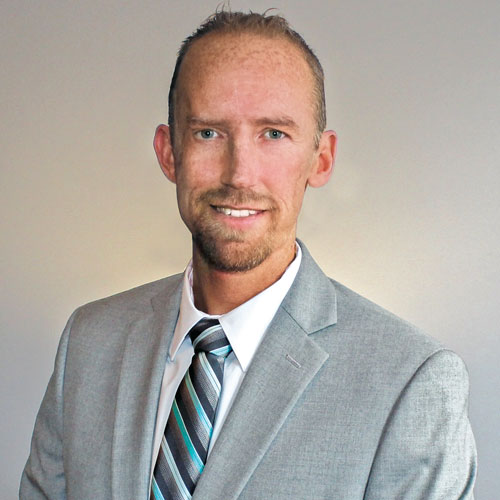
Photo: David Anderson
All at your fingertips
John Deere began working alongside OnLink in 2017; two years later, they purchased the management software and, in the years since, they’ve added several new features.
David Anderson, product manager for John Deere, spoke with Golfdom about the software and how it makes superintendents’ jobs easier from the equipment and labor side.
“On the equipment side, you can keep up with recommended services. We’ve got recommended service intervals, labor and parts so the equipment manager (or superintendent) can know what to do and when and be ready for those services when the time comes.”
Anderson says OnLink also allows equipment managers to lock out the use of specific equipment if it is, for instance, in the shop.
New in 2022 to the program is the ability to track where equipment is and has been on the course. OnLink’s telematics system provides real-time usage analysis to users. Anderson says that data is key to superintendents identifying operational inefficiencies.
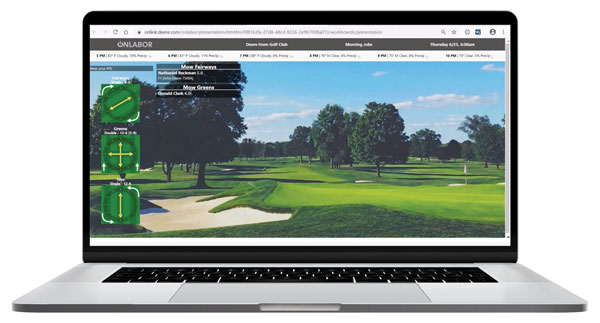
John Deere’s OnLink system allows for the creation and editing of job boards from anywhere. (Photo: John Deere)
Anderson says the driving force behind the software is harnessing data to help enable decisions down the road. In keeping with that theme of harnessing data, OnLink also has a labor-management side, where superintendents and teams plan the day or weeks and assign tasks to staff. The software takes those assignments and presents them to the staff in an easy-to-read format on a monitor in the maintenance facility. The time spent by staff on the task and the costs incurred performing it are automatically recorded, cataloged and available to the user through lab reports.
“Throughout the day, jobs change, things change and the job morphs,” Anderson says. “Instead of having to run back and forth between the clubhouse or tracking someone down on the course to tell them, ‘Hey, your job has changed,’ those updates are reflected immediately on the boards.”
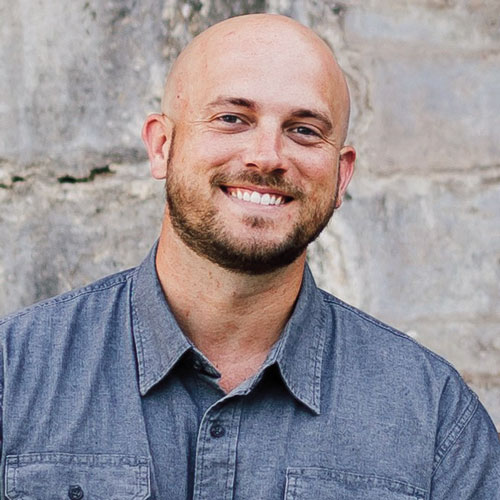
Photo: Mike Rollins
Make old tech new again
Grinders aren’t necessarily a new technology, but in the eyes of Mike Rollins, eastern regional manager, SIP Grinders, they’re very much underestimated.
“Most superintendents I’ve met underestimate what grinders truly are capable of, and they under-utilize properly paralleled reel setup,” he says. “It’s one of the most impactful practices they can incorporate into their turf management programs.”
SIP’s newest technology, which has superintendents like Thad Thompson, superintendent at Terry Hills GC in Batavia, N.Y., excited, is the V-Pallet — an add-on to SIP’s Ideal 6000 unit. “Our technology isn’t necessarily new to the industry; we made the first commercially viable reel grinder in 1902,” he says. “We’ve been making a surface plate reel grinder since 1994, and we’ve been using the V-Pallet since 2014.”
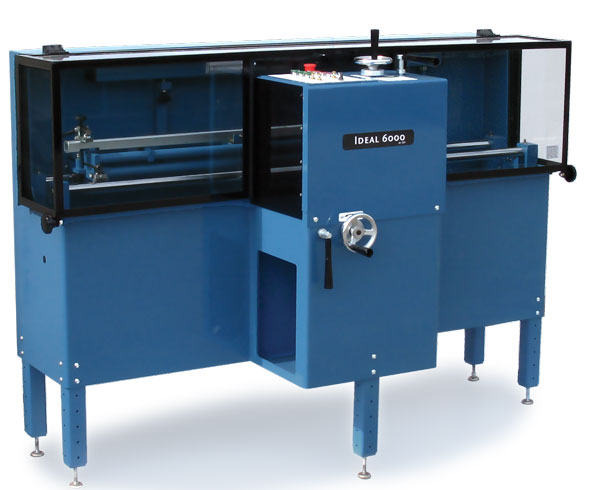
The Ideal 6000. (Photo: SIP)
The V-Pallet, according to Rollins, is the only bedknife grinder that grinds the cut of its knife parallel to the pivot bolts.
“That eliminates any quality of cut and after-cut appearance issues because most issues I find start in the bedbar,” he says. In an effort to spread the knowledge of grinders to superintendents, Rollins travels across the East Coast, presenting demos to interested courses.
“People are just now finding out about our technology because they need precision tools to help them set up and diagnose their cutting units in the high-quality, high-demand world of golf course maintenance in 2022.”
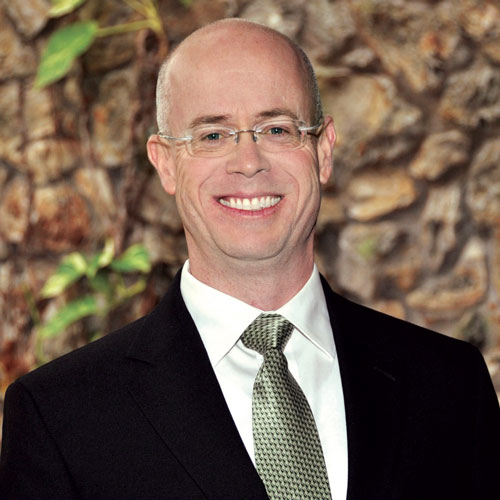
Photo: Bill Stinson
Smart irrigation on the course
Rain Bird’s Cirrus PRO irrigation software doesn’t have an official release date yet — that’s something Bill Stinson, group product manager, and team are keeping under wraps. Still, with feedback received from field tests, Stinson and crew are optimistic it’ll make a significant difference in the life of a superintendent.
As Stinson describes it, Cirrus PRO is a mobile-first irrigation software designed to save superintendents the runaround when it comes to managing irrigation on their course.
“It’s the first (irrigation) software, designed around the mobile user,” he says. “Where previously you had to make Post-it notes in the field and then run back and make changes; now with Cirrus PRO, the user is always connected to the irrigation system.”
Cirrus PRO is a reinvention of the previously released Cirrus system from Rain Bird, with upgrades like programming irrigation by seconds, volume, application or number of sprinkler rotations. According to Stinson, Rain Bird has optimized the program for mobile, making it an easy transition for those used to the desktop version.
The app has the full functionality of the Cirrus program on any internet-connected device. Stinson says Rain Bird improved the maps on the app in addition to the unlimited programs, holes and areas.
“(We thought) how do you improve on that? So, we said we needed to get the superintendent out of the office. Having that powerful software is great, but sitting at a desk isn’t where you want to be,” Stinson says. “We’ve taken Cirrus and removed all the limits. Whatever your property is, Cirrus PRO can handle it.”
Stinson says that in addition to improved maps, the software enables superintendents to have as many team members on the system as needed at the same time.
Stinson says Rain Bird received input from superintendents when designing the app, gaining their perspective on how to make them more effective water managers through using the software.
“Every software build we put out, we get feedback from multiple superintendents, saying ‘Hey, I wish I could do this or that,’” he says. “There’s been extensive feedback, testing and interaction with superintendents to get where we are.”

Photo: David Hules
Always in control
Control is the name of the game with Club Car’s Visage Fleet Management system. David Hules, golf portfolio leader, says the software is an invaluable way to protect the investment of not only golf cars but the turf as well. “(For) ground under repair, wet areas or car path only days, our technology can lock down the car so they can only go on the cart path,” Hules said. “Or if they start to go too close to a green or a bunker, the variable speed car control will take over and reduce the car speed and eventually stop the vehicle if it encounters an action zone configured in this manner. And then, the golfer will have to put the car into reverse to get back into a safe area.”
The system serves a similar purpose as an invisible fence, keeping cars restricted to certain areas of the course.
The other segment of the Visage system is car tracking, which is as simple as it sounds. Superintendents can use GPS technology located inside the car to track where it is at any time. They can also use the software to send messages to the cart through a separate screen located in each vehicle.
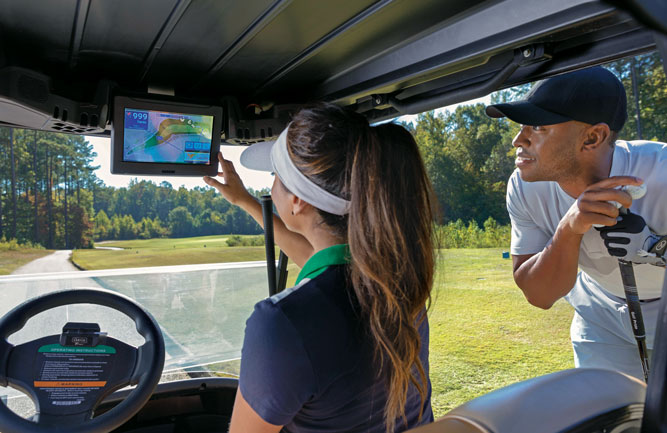
Photo: Club Car
Hules says the system also helps superintendents keep track of the runtime of each car, making fleet rotation easier.
In its current form, Visage is a desktop-only program, but Hules says Club Car is working on a mobile version that will allow superintendents to keep track of cars when they are out on the course.









